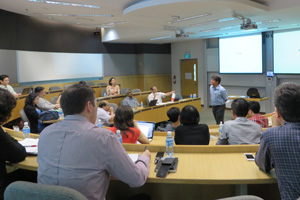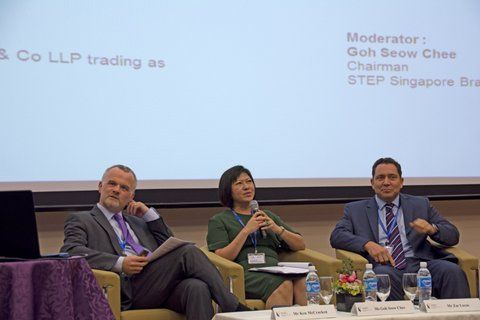
The National Institute of Education (NIE) initiated a sharing session with SMU’s School of Information Systems (SIS) on 9 May 2014. Over 25 research scientists from NIE and faculty members from SIS attended the session, which aimed to explore how information and communications technology (ICT) could be used to support scalable learning for improved student outcomes.
The concept of scalable learning was conceived by renowned scientist, scholar and innovator Dr John Seely Brown to supplant the traditional model of scalable efficiency that leveraged on economies of scale to maximise profit margins and minimise costs. Dr Brown argued that while scalable efficiency had been the linchpin of economic growth in the past, its heavy reliance on consistency and predictability limited organisations’ ability to adapt and innovate. With the emergence of new digital infrastructure significantly accelerating the pace of change in today’s world, this trade-off between efficiency and the ability to learn must be addressed.
Challenges notwithstanding, the trend heralds opportunities to catalyse institutional innovations. To benefit from this, organisations have to embrace scalable learning through the development of new organisational architectures and “creation spaces” that promote interactions and relationships, increase information flow within and across the institution to enhance learning, adaptability and innovation.
With reference to Dr Brown’s proposition, Professor David Hung, Associate Dean for NIE’s Office of Education Research, highlighted in his introductory remarks the role of scalable learning in today’s educational landscape, particularly the promotion of 21st century competencies such as information and communication skills, critical and inventive thinking among students. This would require the design of interactions that not only enables learning, but also empowers student discourse and collaboration.
In this regard, he noted that SIS’s analytics capabilities in the study of student learning interactions would be insightful for NIE. SIS Dean and SMU’s Vice Provost (Research) Professor Steve Miller also added how institutes of higher learning such as SMU could play an active role in helping organisations change their ability to systematise learning.
The session was followed by informative presentations on ICT-based pedagogy and learning programmes. Representing the SIS were Associate Professor Venky Shankararaman who explained the pedagogical approaches that were used to handle challenges associated with teaching enterprise technology courses, and Associate Professor Lee Wee Leong who presented his work on using games to teach project management concepts, and devising intelligent tutoring systems to support business modelling in spreadsheets.
Associate Professor Chris Boesch elicited interest from the audience for his project, which involved automatic assignment of mentors in a web-based platform that was created for students to learn and practise programming. Through his earlier research, Professor Boesch had observed that learning programmes should ideally be structured to challenge students in the top quintile (i.e., top 20%), while supporting those in the bottom quintile. In order to bridge the educational needs of these two groups, he introduced automated mentor assignment features to the platform, which enabled the former to mentor the latter. Students were noted to benefit from increased collaboration and engagement under the blended learning environment. The findings also attested to the scalability of the concept to support different learning needs for a variety of classroom settings.
Representatives from NIE and its Learning Sciences Lab (LSL) also presented their research work in analytics-informed learning for collaborative creativity and 21st century literacies, as well as applications for mobile and game-based learning. Tasked to empower learners through design research centred on meaning-making, enabling tools and participatory cultures, LSL is the first such lab in Asia that is dedicated to transforming learning using interdisciplinary approaches that cut across methodologies and scales of educational theory and practice. Its key areas of focus are: 1) student-generated designs; 2) mobile/seamless learning; 3) new media; 4) embodied cognition); and 5) play/game-based learning.
Well-received by the participants, the sharing session was credited for enhancing mutual awareness and understanding of complementary research areas undertaken by NIE and SMU. It paved the way for further dialogue to explore potential areas for collaboration.
Back to Research@SMU Issue 14 (May 2014)
See More News
Want to see more of SMU Research?
Sign up for Research@SMU e-newslettter to know more about our research and research-related events!
If you would like to remove yourself from all our mailing list, please visit https://eservices.smu.edu.sg/internet/DNC/Default.aspx

